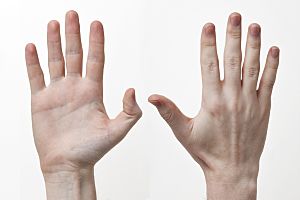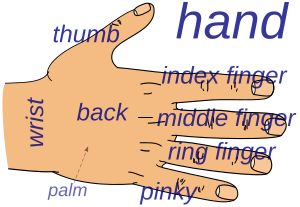Hand facts for kids
A hand is the part of your body at the end of your arm. Most humans have two hands. Each hand usually has four fingers and a thumb. The inside part of your hand is called the palm. When you bend your fingers tightly, your hand forms a fist. The hard parts of your fist are called knuckles. Many other animals, especially other primates, also have hands that can hold things. However, human hands can do many special things that other hands cannot.
Contents
What Makes Up a Hand?
Many mammals and other animals have parts that can grasp, like paws or claws. But these are not truly considered hands. Real grasping hands are only found in a group of mammals called primates. Hands also need to have thumbs that can move to touch other fingers.
The main parts of a human hand include:
- The palm, which is the flat, inner surface.
- The fingers.
- The thumb.
Your four fingers can bend over your palm. This allows you to hold onto objects. Each finger has a common name to tell it apart from the others. Starting from the one closest to your thumb, they are:
- The index finger, also called the pointer finger.
- The middle finger, which is usually the longest.
- The ring finger.
- The little finger, also known as the pinky finger.
How Hands Changed Over Time
The hands and feet of primates that can grasp things evolved from the movable hands of small, tree-dwelling animals. These animals were like tree shrews and lived about 60 million years ago. As hands developed, important changes also happened in the brain. Our eyes also moved to the front of our face. These changes helped us control our muscles and see in 3D, which is needed for careful grasping.
About 3.6 million years ago, early humans (called Hominidae) started walking upright on two legs. This bipedal posture meant their hands were free from helping them move around. This freedom allowed human hands to develop amazing precision and a wide range of motion. Scientists believe that the way early humans walked upright might have helped them use their bodies to make their hands stronger. This was important for using early stone tools.
Cool Facts About Hands
- The skeleton of a human hand has 27 bones!
- Human hands have special features. Our thumbs are longer than those of other primates. We can also control our fingers more individually.
- An adult male human hand weighs about one pound.
- A sure way to tell human hands apart is by their opposable thumbs. This means the thumb can touch all the other fingers.
- Your fingers have many nerve endings. They are very sensitive to touch. This is why your sense of touch is closely linked to your hands.
- Like your eyes or feet, each hand is mostly controlled by the opposite side of your brain. So, if you are right-handed, the left side of your brain is more in charge.
- Hands are very important in body language. They are also used in sign language to communicate.
- The ten fingers on two hands and the twelve phalanges (bones in your fingers) on four fingers (that your thumb can touch) have helped create different number systems and ways to count.
Related pages
Images for kids
-
Image showing the carpal bones
-
X-ray of the left hand of a ten-year-old boy with polydactyly.
-
Static adult human physical characteristics of the hand.
See also
 In Spanish: Mano para niños
In Spanish: Mano para niños












